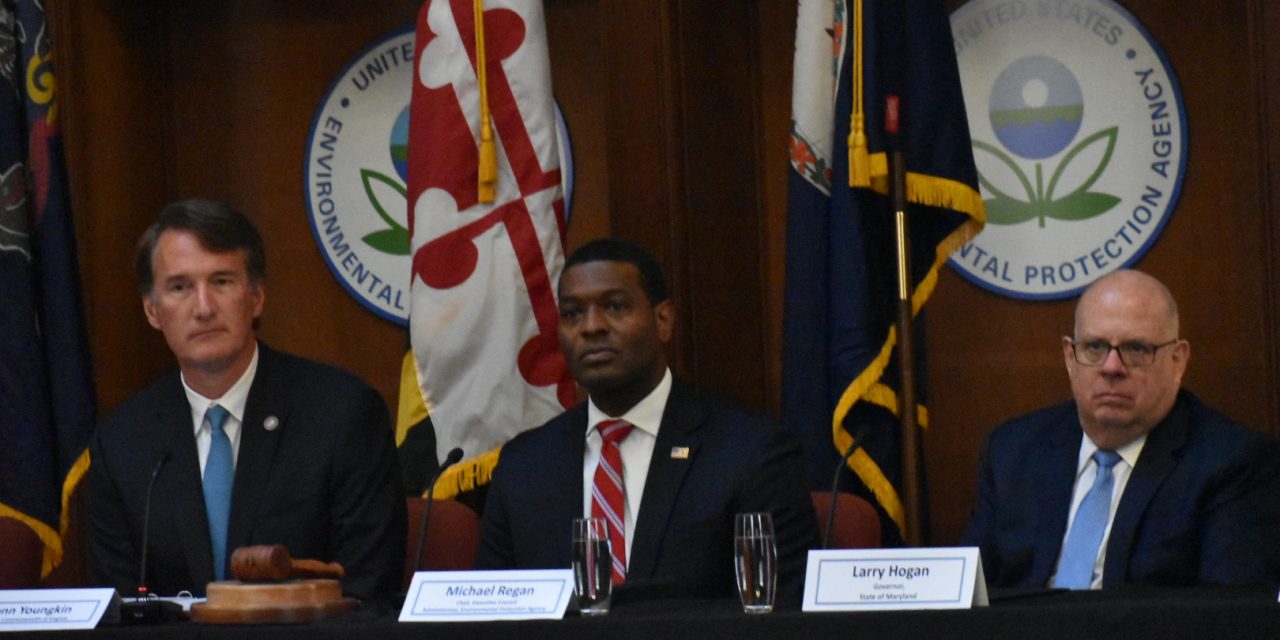WASHINGTON – The leaders of efforts to restore the Chesapeake Bay by 2025, a group that includes six governors, the Environmental Protection Agency, and the mayor of the District Columbia, acknowledged Tuesday they have not been doing enough to reach their goals
They did not say how they would achieve their targets. The group, the Chesapeake Bay Executive Council, was attending its annual meeting. The council includes the governors of Maryland, Virginia, Pennsylvania and three other states in the bay watershed.
Officials began the meeting by commending the overall progress in bay restoration efforts but highlighted the work yet to be done outlined in the Chesapeake Clean Water Blueprint. The blueprint tasks each state and Washington with reducing a set quantity of pollution.
Ann Swanson, director of the Chesapeake Bay Commission, told the governors, including Maryland Gov. Larry Hogan, R, Virginia Gov. Glenn Youngkin, R, and officials from Pennsylvania, Delaware, and New York, to increase the pace of their conservation efforts.
“Bottom line here is that water quality is improving,” Swanson said. “Have you met water quality standards? No.”
“You have voices that are extremely unique. You’re the commanders in chief, and so if you speak strongly, there are tens of thousands that will respond to you.”
A report released by the EPA last week said only West Virginia and Washington are on track to meet their pollution reduction objectives.
A similar report conducted by the Chesapeake Bay Foundation, the lead environmental watchdog for the bay, found that bay states are on track to reduce nitrogen pollution by 42% and phosphorus pollution by 64%, with only three years left to achieve the full 100% reduction.
Nitrogen and phosphorus are nutrient pollutants with profound effects on bay water quality, and a high concentration of them can spur algae blooms, which deprive water of oxygen and introduce harmful bacteria, according to the EPA.
Officials at the meeting emphasized that programs geared towards sustainable farming practices — such as planting trees between farms and bay tributaries — can filter nutrient pollutants in crop fertilizers and animal waste, thereby reducing nitrogen and phosphorus loads.
Improved stormwater filtration is also needed to reduce pollutants to a manageable level, officials said.
EPA Administrator Michael Regan said that in a discussion before the council’s public meeting, officials redoubled their commitment to charting a clear path to build and sustain partnerships in restoring the bay.
“We agreed to ask our principal staff committee to rethink how we celebrate our work through 2025 and beyond,” Regan said. “We need a clear path forward that prioritizes an optimized message for achieving our goals.”
Regan hinted that the council may have to reconsider its 2025 deadline.
“We’ve all acknowledged that 2025 is fleeting in terms of achieving our goal,” he said. We’ve tasked our staff to take a look at what we can achieve between now and 2025. What are we going to do to get back on track?”
Hilary Harp Falk, president of the Chesapeake Bay Foundation, said she hopes the plan the council is promising will include more conservation spending and greater pollution enforcement.
“We need realistic plans and a significant increase in funding and accountability,” Falk said in an interview with Capital News Service after the meeting. “The great news is that the council has an accountability framework. They just need to continue to use it.”
Hogan said his administration will hold industrial polluters accountable. Hogan pointed to the failures of two wastewater treatment plants owned by Baltimore that led to the release of untreated discharge that motivated Maryland to file a lawsuit against the city.
“This has underscored the importance of making sure that our restoration investments are well maintained, and continue to perform as designed throughout their lifespan,” he said.
Youngkin immediately acknowledged his state’s failure to reach its goals, but blamed the previous administration. Instead of committing to the immediacy of restoring the bay, he called the 2025 deadline an “artificial expiration date.”
Falk rejected Youngkin’s response.
“We needed to create some hard metrics,” she said. “So, 2025 is important for a number of reasons.”




Recent Comments